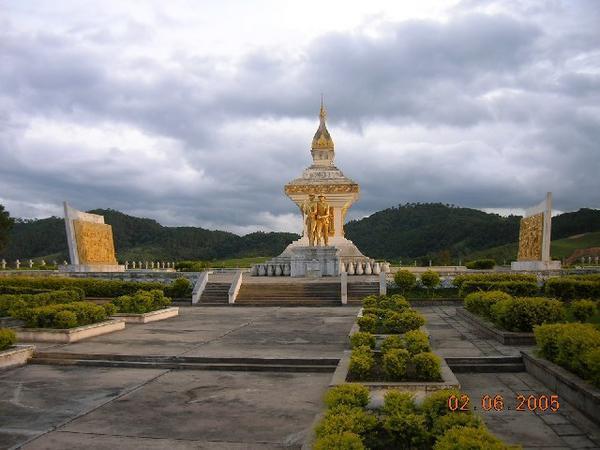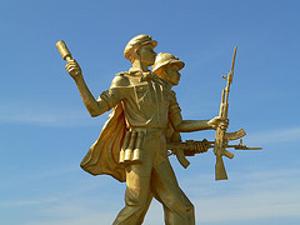 |
| Vietnam War memorial in Phonsavan, Laos |
|
|
WAR MEMORIALS
|
|
South of Phonosavan are two major war memorials set 1 km apart on separate hill tops. Both are set in the style of traditional Laos stupas (each containing the bones of the dead) although one is representative of the Vietnamese and the other the Laos lives lost. Inscribed on the Lao monument is the slogan ‘The nation remembers your sacrifice’, erected in 1998 a nearby slab of granite has the names of all the soldiers lost inscribed on its surface. The Vietnamese war memorial has the inscription ‘Lao-Vietnamese solidarity and generosity forever’. Both memorials enjoy sprawling views of the countryside and are especially attractive at sunset.
|
|
 |
| War memorial shows North Vietnamese and Pathet Lao soldiers attacking during the Vietnam War. |
|
|
Hanoi (Vietnamese: Hà Nội) pronunciation (help·info), estimated population 3,398,889 (2008), is the capital and second-largest city of Vietnam. From 1010 until 1802, it was the most important political centre of Vietnam. It was eclipsed by Huế during the Nguyen Dynasty as the capital of Vietnam, but Hanoi served as the capital of French Indochina from 1902 to 1954. From 1954 to 1976, it was the capital of North Vietnam.
The city is located on the right bank of the Red River. Hanoi is located at  21°2′N 105°51′E / 21.033°N 105.85°E / 21.033; 105.85Coordinates: 21°2′N 105°51′E / 21.033°N 105.85°E / 21.033; 105.85Coordinates:  21°2′N 105°51′E / 21.033°N 105.85°E / 21.033; 105.85, 1,760 km (1,090 mi) north of Ho Chi Minh City, formerly called Saigon. 21°2′N 105°51′E / 21.033°N 105.85°E / 21.033; 105.85, 1,760 km (1,090 mi) north of Ho Chi Minh City, formerly called Saigon.
October 2010 will officially mark 1000 years of the establishment of the city. On this occasion, Hanoi has been named as one of the world's "Top Destinations 2010.
|
H
a
L
o
n
g
B
a
y
|
![]()
|
Ha Long Bay (literally: Bay of Descending Dragons; Vietnamese: Vịnh Hạ Long) is the most well-known touristic destination in Viet Nam, and this is for good reason. It is a UNESCO World Heritage site located in Quảng Ninh province. If you've focused your trip on the extraordinary cities and monuments of urban Vietnam, a visit to Ha Long Bay leaves no doubt that Vietnam also has some of the most beautiful natural sceneries worldwide.
The bay features thousands of limestone karsts and isles in various sizes and shapes. The Ha Long bay, dotted with some 2000 limestone islets rising from emerald waters, is the best known natural wonder of Viet Nam. The islands were formed from limestone sediments deposited at the bottom of an ancient ocean. As the seas rose and fell over millennia, the soft limestone was easily shaped into the towering monoliths (geologists call them karst formations) as we see today. The forces of erosion also riddled the islands with caves, more than 20 of which are open to tourists. Because of their precipitous nature, most of the islands are uninhabited and unaffected by a human presence. The outstanding scenic beauty is complemented by its great biological interest. The islands feature endless numbers of beaches, grottoes, and caves. The bay is a sea islands in tropical wet with 2 seasons: hot and moist summer, dry and cold winter. Average temperature is from 15°C- 25°C. Annual rainfall is around 2000mm.
In the shallow waters of the bay, there are more than 200 species of fish and 450 different kinds of molluscs. Often the shape of an island determines its name, such as Voi Islet (elephant), Ga Choi Islet (fighting cock), and Mai Nha Islet (roof). Birds and animals, including antelopes, monkeys, and iguanas, also live on some of the islands. Cat Ba Island is a UN Biosphere Reserve and home to many rare species.
Archaeological evidence reveals that humans have settled near Ha Long Bay since at least 3,000 B.C. The bay is no stranger to conflict. In 1288 General Tran Hung Dao stopped Mongol ships from sailing up the nearby Bach Dang River by placing steel-tipped wooden stakes at high tide, sinking the Mongol fleet. Today General Tran Hung Dao (Hung Dao Vuong) is revered throughout Vietnam. You can visit the Dau Go (Cave of the Wooden Sticks), where legend says the wooden sticks that sank the Mongol fleet were stored.
|
Through what was known to thousands of GIs and Marines as Dogpatch, the village outside the Da Nang Airbase. Past Dogpatch was the Marine Corps Freedom Hill Processing Center and the Freedom Hill PX complex. The old processing center is now the People's Army of Vietnam and the PX area at the bottom of Hill 327, is the site of a gravel and slate mining operation.
Thousands of Marines like myself went through the Freedom Hill center first coming In Country and then to Freedom, hence the name. Click Here
|
Here are a few photos of Camp Reasoner in Da Nang as it looks today.
|
|